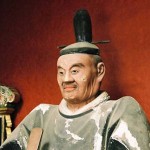“There may be a hundred sword stance positions, but you win only with one.” – Yagyu Munenori, from the Heiho Kadensho (The book of Family Traditions on the Art of War).
With Miyamoto Musashi known as the most famous swordsman in history, it is only fair and appropriate to bring up Master Munenori, founder of the Edo branch of the Yagyu Shinkage Ryu sword style, and is regarded as a contemporary rival of Musashi’s.
The photo to the left is of a wooden statue in Hotokuji Temple of Yagyu Munenori. The hyperlink also has a picture of his grave marker, as well as the Priest Takuan Soho (who will will be discussing a little here, but also on a page of his own…)
Munenori was born in 1571, near the end of the Sengoku period, during an overlapping Shokuho period, and was about 33 years old when one of the two most famous periods in Japanese history – the Edo (or Tokugawa) period – began. Essentially, he was born and raised during a time of major political change and upheaval – the Sengoku period is also known as the Warring States period, and was a time of intense development of the Martial Arts in Japan.
Contrary to Musashi’s experience and training, Munenori received official training in the ways of the sword by his father, Yagyu Muneyoshi, and would later take up his sword in the service of Tokugawa Ieyasu – eventually becoming the chief sword instructor to the Shogun’s son, Tokugawa Hidetida, as well as the becoming head of the Shogunate’s Secret Police force.
Musashi applied to become the Shogun’s sword master, but his application was denied as Munenori was already employed as such, as well as being a major political retainer for the Shogun.

Tokugawa Family Crest
Yagyu Munenori earned his reputation in the Battle of Sekigahara (circa 1600), the decisive battle that lead the way for Tokugawa Ieyasu’s push to become Shogun, as well as at the Siege of Osaka.
Interestingly, it is alleged that Miyamoto Musashi also fought in these two battles, although he would have been approximately 16 years old at the time of the former, and 30 at the time of the latter… although he was one of the swordsmen fighting on the side of Oda Nobunaga, Ieyasu’s rival.
Both Munenori and Musashi, obviously, survived both… and very little is known about what Musashi did during these battles.
Another linkage between the two legendary swordsmen was Takuan Soho – a Zen Buddhist priest of the Rinzhai school. Both Munenori and Musashi would be influenced by Zen through him, although (of the two) only Munenori would have him as a mentor. Consequently, Munenori’s book (The Life-Giving Sword (Heiho Kadensho), written circa 1632, would have major Zen Buddhist leanings. Although Musashi’s Go Rin No Sho (The Book of Five Rings) wouldn’t be written for another 13 years, Munenori’s book would situation itself in-between the extremes of Soho and Musashi. Soho’s work, the Mysterious Record of Unmoving Wisdom (Fudoshi Shinmyoruki) is a philosophical review of the sword and its practices from the vantage point of Zen Buddhism, while Musashi’s work is a treatise on the practical application of the sword… Munenori’s work is a balance between these two, taking on a poetic and philosophical flavour of the practical way of the sword. His work is a primer for techniques already learned, as well as for the meditative practices of training, amongst other things.
When Munenori was 35 years old, his father (Yagyu Muneyoshi) and patriarch of his sword style died, but passed on the leadership of the style to his grandson – Munenori’s nephew, Yagyu Toshiyoshi… This was, apparently, an almost political move as Munenori’s father believed that his grandson (the son of his eldest son) would make a more suitable successor for the family’s sword style, while the headship of the family name would go to Munenori. It is Toshiyoshi’s sword style that survives into the modern world, and it was also Toshiyoshi who would have a chance meeting and discussion with Miyamoto Musashi, while his uncle never had the same opportunity…
Munenori’s “Edo Shinkage Ryu” would not survive into the modern era, as he was the sword instructor to the Shogun, as well as having his political positions, and thus wouldn’t have the time to pass on his portion of the style… He died peacefully in 1645, fondly remembered and revered by the Shogun of the day – Tokugawa Iemitsu, who would still say things like “If only Munenori were here; I could ask him about this” after his advisor’s passing.
Ultimately, his written works are one of the three major foundational writings that many modern Martial Artists read to reconcile the ideas of conflict/combat with meditation and peace. The title of his work is evocative, juxtaposing the common understanding of the purpose of a sword with the power that it has in the hands of the right wielders – that action at the appropriate time can take a weapon of death and, through it, grant life… A strike against an aggressor who is intent of killing someone can save that someone – even though it may likely kill the aggressor…
“It is bias to think that the art of war is just for killing people. It is not to kill people; it is to kill evil. It is a stratagem to give life to many people by killing the evil in one person.” – Yagyu Munenori, The Life-Giving Sword.



1 ping
[…] Yagyu Munenori […]